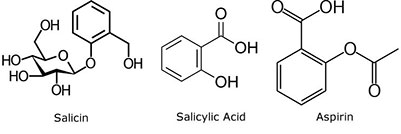Last month a small panel reviewed applicants for the David Miller Travel Bursary Award, which is sponsored by SCI, VHB Herbs and the Eden Project. In all, we had 19 applicants from 14 universities and research centres. The two winners are:
- Amanda Livermore from Reading University who will be travelling to Tunisia to learn a new bioassay technique for aphid pathogenic bacteria.
- Clive Ludquist from Bristol University will go to Brunei to investigate plant iridescence.
These winners will be invited to attend our AGM on 21 September and a report on their travels will be published later in the year.
On 21 June we will be visiting Harcourt Arboretum near Oxford to view the developments that have taken place in recent years - all are welcome.
On 2 July the BioResources Group are organising the SCI Young Researchers in Agrisciences 2013: Crop Production, Protection and Utilisation meeting at Reading University.
Please also remember to book your place at the VI International Conference on Managing Quality in Food Chains at Cranfield University on 2 -5 September.
In March, the Professional Horticulture Group South West (PHGSW) visited several west country businesses and gardens. Most of these visits have been reported in earlier Newsletters. Here we conclude the series with a report on Lanoyce Nursery, a specialist Alstroemeria nursery supplying one of the major supermarkets.
Last month Warwick Crop Centre began a fortnightly series of lunch-time seminars. These are given by Crop Centre staff interspersed with visiting speakers. Below you will find a report on the first of these seminars given by two members of the staff, Charlotte Allender and Mato Lagator.
Editor
Lanoyce Alstroemeria
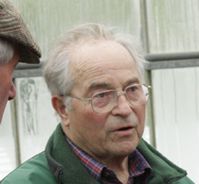
The present owners, Alan and Martin Rickard (pictured right), took over from their strawberry-growing father in 1966. Looking for new crops to grow they were pointed in the direction of Alstroemeria by Sussex grower, Alan Frampton, and by 1972 it had become their main crop. Initially the flowers were sold locally through their own florist shops and around 45 other shops in the area. However for the last 16 years they have supplied around 75% of their crop to Sainsbury's, the remainder still going to local shops.
At the start they purchased all their plants from the Dutch breeder, Van Staveren, but now they grow varieties from four Dutch breeders. The plants, which need replacing after 3 to 4.5 years, are purchased royalty-free from the breeders and the company then pays a royalty for each square metre of production. There is a constant search for new varieties, in particular for those that are productive, have a good upright habit and the strong flower colours, according to customer demand.
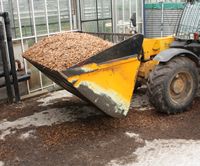
When a cropping bed has started to decline after 3-4 years the plants are cut down and the beds sheet steamed using a mobile boiler prior to replanting.
A further economy has been made by installing a solar panel array adjacent to the glasshouses which now supplies all their electricity.
Alstroemeria is not a crop particularly affected by pest and disease, but they maintain a few aubergine plants at the end of each row to attract whitefly off the crop. This enables control with Encarsia wasps to be localised on these plants.
In their packing shed they have the machinery for leaf stripping, stem cutting and bunch packing as well as a cold store to keep the flowers fresh until they are collected in cool chain lorries. Altogether this well-run nursery runs on 12 staff augmented with up to 20 casuals during the peak cropping periods.
Peter Grimbly
Warwick Crop Centre - 9 May
'Genetic Diversity and Conservation of F1 Hybrids in Genebanks', Charlotte Allender
Charlotte Allender is the Manager of the Genetic Resources Unit at the Warwick Crop Centre, a seed bank that maintains several globally significant collections of vegetable crops and related wild species. She explained the objective of the seed bank is to collect and maintain as wide a range of genetic variation as it can of the crops it specialises in. This variation can come from wild species, old landraces selected by farmers and growers using simple selection, and cultivars obtained by plant breeding.
These days, many of the latter are F1 hybrids produced to combine desirable characters in a more uniform crop. They do however pose a number of problems to a gene bank. First and foremost they do not by definition breed true to type so cannot be maintained using the practices established for more traditional varieties. In addition, in out-breeding crops there may well be a series of incompatibility genes and their numerous alleles (mutations); part of the species own mechanism to prevent self-pollination and inbreeding. Such is the case in the genus Brassica, one of the crops the gene bank specialises in.
Charlotte's first task in investigating these problems was to establish if there was genetic variation in F1 hybrids worth preserving. Using the Brussels sprout collection as a test, she was able to show that an F1 hybrid has as much variation as an older open-pollinated variety and more importantly held new variation not present in the latter.
Having established that the maintenance of the variation in F1 hybrids was worthwhile, the next stage was to establish the best way of maintaining them. Although the potential problems expected with F1 hybrids suggested alternative approaches such as bud pollination (hand pollination before the incompatibility mechanism is fully active) and mixed pollination (crossing a mixture of two F1 hybrids) she found that the traditional technique of open cross pollination between plants from a single F1 family was most effective at maintaining and preserving the range of alleles present.
A potential issue observed was the possibility of a wide variation in pollen production. Computer-based simulations indicated that the greater the uneven nature of pollen production, the more severe the effect on the plant population in terms of the accidental loss of genetic diversity during regeneration. This could lead to a significant bias in the variation present in the next generation and remains a problem still to be addressed.
'Is Sex Good for You? Adaptation in Sink Environments', Mato Lagator
Mato Lagator had chosen this title with the expressed intent of attracting an audience. In reality the ubiquitous presence of sex across the plant and animal kingdoms suggests sex must be good and the real problem he was addressing was the second part of the title. In effect, how do organisms adapted to one environment re-adapt to a new environment and particularly what effects do sex and migration have on the process. Migration in this instance refers to the movement of a population from its normal 'source' environment to a new 'sink' environment to which it must adapt.
Mato had chosen the development of resistance in Chlamydomonas reinhardtii to herbicides as his model for this study. This unicellular alga adapts readily to a number of herbicides and has the added advantage that it normally reproduces asexually but can be induced to reproduce sexually by nitrogen starvation.
He compared asexual reproducing populations with populations where sexual reproduction was induced every third reproductive cycle. These populations were studied over 26 reproductive cycles with and without the presence of one of three herbicides. These latter are the 'sink' environments. He found that while both populations developed a high level of herbicide resistance within this period the sexually reproducing population developed resistance faster and attained a significantly higher level of resistance at the end - sex was good for the process.
He also compared populations where migration was allowed, i.e. a proportion of individuals from the source population were added at each generation potentially adding additional variation to the adapting population. Initially this did just that and accelerated the process of adaptation. However, there comes a point at which virtually all the available variation in the source population has been utilised and then further migration has the effect of slowing the process and preventing it reaching a full level of resistance. Sex and migration are initially complimentary but then interact negatively.
Since sex is undoubtedly beneficial and migration can become a negative influence this provides a potential driver for barriers to develop to prevent the populations in the source and sink environments from interacting, ie speciation is encouraged.
Plant of the Month
Cydonia oblonga, quince, Rosaceae
Now in bloom, the beautiful quince trees (picture right), will yield their fragrant harvest much later in the year. These trees are fairly small and deciduous like the more familiar apples and pears of the same botanical family. It originates from South West Asia, Turkey and Iran but grows well through the British Isles.
The cultivation of quince is thought to have preceded the cultivation of apples. It was certainly a fruit favoured by both the Romans and the ancient Greeks.
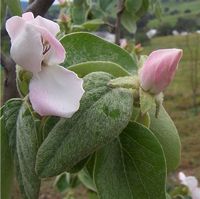
The fruits themselves are a golden yellow colour and may not fully ripen in the UK climate. In southern areas where they do ripen fully they may be eaten raw, but they are definitely best cooked here. The fruits are rich in pectin and make an excellent jam which goes well with cheese. Many different cultures have their own versions of quince jam - dulce de membrillo, from South America and Spain possibly being the most well known. In Portuguese, the fruit is known as marmelo and quince jam became known as marmalade.
Alison Foster
Oxford Botanic Garden
Medicinal Plant of the Month
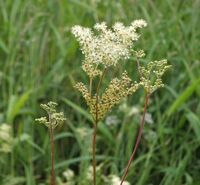
Whilst many people associate the story of the development of aspirin with the white willow, fewer will think immediately of meadowsweet in connection with this widely used painkiller.
Salicylic acid was first directly isolated from Filipendula ulmaria in 1839. A German chemical company, Bayer, were investigating the medicinal properties of salicylic acid and sought to make an analogue that had an improved safety profile (salicylic acid irritated the stomach lining). Acetylated salicylic acid was found to be effective and this is the drug we know today as aspirin. At the time when salicylic acid was isolated the plant was actually named Spiraea ulmaria and 'acetylated spiraea' became aspirin.
Aspirin today is produced via chemical synthesis. It is one of the most recognised drugs across the world and is used to treat dull pain, fever and migraine. It is also taken as a preventative for heart attack, stroke and deep vein thrombosis (DVT). Salicylic acid is also used today in medicine as a topical agent either alone or in combination with other drugs to treat a range of skin conditions such as warts, verrucas and psoriasis.
Meadowsweet is a perennial plant native to much of Europe and Western Asia including the British Isles. It is commonly found growing in damp habitats alongside river banks, on the edges of ponds and in meadows. When crushed the whole plant has a pleasant sweet smell.
Alison Foster
Oxford Botanic Garden
News from our Associates

The Society responded to a call for views from the Director General, Knowledge and Innovation at the Department for Business Innovation and Skills on the key priorities and challenges for the science and research budget ahead of the 2013 Comprehensive Spending Review. The response highlights the importance of public funding as a key driver for business and charitable investment in science, and asks that investment in research and development is stablised and grown in order to ensure the future of the UK's impressive and productive science R&D sector.

UKPSF organised this year's Fascination of Plants Day on 18 May. A large number of events were organised around the country. Margaret Waddy attended one such event at Cambridge Botanic Garden and she will report on her experiences in a future edition.
Horticulture Industry News
For the very latest horticultural news follow us on Facebook,
Twitter or Linked In.
How ozone protects fruit from decay
It is known that low levels of ozone gas can protect fruit and vegetables from disease, and increase their shelf life but, until now, not why it works. A team found that changes in the proteins observed when a tomato fruit was treated with ozone after it had been harvested were associated with defence and signalling responses.
The mechanistic relationships are still rather poorly understood but responses are believed to be associated with physical and chemical defence responses, as well as enhanced repair capacity. The scientists also showed that storage of fruit in enhanced levels of ozone inoculates it against pathogens for up to two weeks afterwards, even once it is removed from the ozone-enriched atmosphere. More
How do plants grow toward the light
The growth of plants toward light is particularly important at the beginning of their lifecycle. With the help of highly sensitive light-sensing proteins, they find the shortest route to the sunlight - and are even able to bend in the direction of the light source. The most important proteins in this process are the export proteins known as 'PINs', which regulate the direction of the auxin flow. However, these PINs do not function on their own: They require the signal of the D6PK protein kinase. This kinase enzyme modifies the PINs through the transfer of phosphate groups - thus activating them as auxin transporters. More
Social Dimensions of Organic Production
During the early period, organics were based on local and regional systems dominated by direct sales and an anti-industrial philosophy. As demand has grown two systems have developed; one still bedded in local distribution while the other is large in scale and uses similar lengthy distribution systems to conventional production. As this 'conventionalised' system becomes more widespread and dominant the early ethos of organics is supplanted by a system identical in most respects to that for non-organics and the original social dimensions have been lost.
Early-flowering woodland plants have slow ripening seeds
Snowdrops and daffodils flower early to take advantage of the available light before the tree canopy develops. However, low temperatures mean seed development is slow.
Now researchers have found that the seeds disperse when still moist and immature. They then continue to develop on the woodland floor. The closure of the tree canopy and increased shading as the undergrowth thickens creates the humid atmosphere in which embryos continue to develop within seeds throughout the summer, with maturity and germination occurring with the drop in temperature in the autumn.
Sweet chestnut blight - the latest threat to Britain's trees
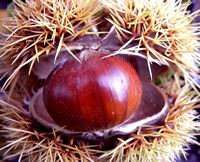
An infection of the blight is usually fatal to sweet chestnuts. It causes a characteristic bright brown cankered bark, in contrast to the greenish colour of normal bark. After it was first detected in North America in the 1930s it went on to kill an estimated 3.5 billion trees within 20 years. More
Tree stumps improve agricultural productivity
There's a received wisdom that tree stumps, shoots and bushes should be cleared from a field before planting crops.
It seems logical, but the experience of farmers in southern Niger suggests otherwise. There, the practice of Farmer Managed Natural Regeneration (FMNR) has been found to significantly improve soil quality and crop yields, along with additional resources and income from tree products. FMNR takes advantage of living underground root systems of previously cleared trees.
Rather than remove new shoots, farmers nurture five or so of the strongest, most upright stems, pruning the rest away. These stems are allowed to grow, and some are harvested for firewood and timber. The presence of shrubs and trees helps fix nitrogen in the soil and lessens wind erosion so that seeds don't blow away and have to be replanted, while falling leaves scattering around fields enrich the soil.
Farmers now get 500kg of millet per hectare where previously they only got 150kg. More
Ginger compounds may be effective in treating asthma symptoms
Researchers at Columbia University have shown that purified components of the ginger root also may have properties that help asthma patients breathe more easily.
Asthma is characterized by bronchoconstriction, a tightening of the bronchial tubes that carry air in to and out of the lungs. Bronchodilating medications called beta-agonists (beta-agonists) are among the most common types of asthma medications and work by relaxing the airway's smooth muscle (ASM) tissues.
This study looked at whether specific components of ginger could help enhance the relaxing effects of bronchodilators. The researchers found that tissues treated with the combination of purified ginger components and the beta-agonist, isoproterenol, exhibited significantly greater relaxation than those treated only with isoproterenol; of the three ginger components, 6-shogaol appeared most effective in increasing the relaxing effects of the beta-agonist.
HDC precision herbicide research moves toward commercialisation
Precision technology that will allow reduced herbicide use by accurately identifying and spot-spraying weeds, developed from research funded by the Horticultural Development Company (HDC), is to go into commercial production.
The prototype device combines an innovative image analysis-based system for identifying a variety of weeds in row crops, coupled with a choice of two precision spraying modules to directly apply herbicide either to single spots or to small patches of weeds.
Turning the leaf into a biodiesel factory
Two of the prime challenges in bioenergy research are to improve the yield of biomass crops and to make the stored carbon more available for conversion into liquid biofuel. The most productive biomass crops are fast-growing trees and grasses, which store carbon in their leaves and stems as lignocellulose.
This material is hard to convert into liquid biofuel because it is extremely resistant to degradation. In contrast, vegetable oils from seeds can easily be made into biodiesel. This has led to the suggestion that biomass crops should be made to store carbon as oil. Scientists at Rothamsted Research have now used synthetic biology principles and techniques to identify a combination of genes that increases the oil content of vegetative tissues by at least 400-fold in the model plant Arabidopsis.
A key to achieving such high levels of oil is the discovery that oil breakdown severely limits oil accumulation in these tissues and can be switched off by removing a single gene called Sugar Dependent 1. More
Parasitic wasps use calcium pump to block fruit fly immunity
Parasitic wasps switch off the immune systems of fruit flies by draining calcium from the flies' blood cells, a finding that offers new insight into how pathogens break through a host's defences. The researchers showed how a wasp version of a conserved protein called SERCA, which normally functions to pump calcium from the cell cytoplasm to the endoplasmic reticulum, can block a host's cellular immune response.
Before the study, there were hints that calcium signalling was important for blood cell activation following infection, but the fact that a parasite actively suppresses this signalling shows how important it is. More
Invasive ladybirds wage 'biological war' on natives
In recent years harlequin ladybirds have escaped and rapidly established themselves across Europe and North America at the expense of native species. In Autumn, these Asian invaders can be a nuisance as they congregate in large groups searching for sheltered locations to hibernate and can sometimes cause serious allergic reactions in humans.
Scientists have now shown that it is the biological system of the harlequin ladybird that gives it the edge when it comes to competing with native species. The body fluid of the insect contains a strong antibiotic compound called harmonine as well as antimicrobial peptides. These allow the invasive to fight off pathogens more effectively than natives.
So powerful are the antibiotic elements in the ladybird, that the researchers say they may prove to be promising targets for drug development. But the most powerful aspects of the ladybird's biological armoury are tiny fungi which are inactive in their own blood, but when native ladybird beetles start to attack the invader's eggs and larvae, they become active and kill the native ones. More
Using salt solution to dehumidify air in greenhouse
To dehumidify air in a greenhouse, Wageningen University in the Netherlands researched the use of a salt solution in a commercial greenhouse. The general conclusion is that it works well. Air from the greenhouse is passing by a concentrated salt solution. This creates heat which is harvested and used to heat the dried air which is moved back to the greenhouse.
In theory, 50% of energy used can be saved. This has been tested for a year in a greenhouse by blowing air in through a pad wall with a flowing salt solution. The salt was dried by a vacuum evaporator and a heat pump to recover the water and energy.
Non-browning GMO apples may be deregulated in US by the end of 2013
Genetically modified (GM) crops have been part of the US food supply for several years. However, only one type of GM fruit, the Hawaiian papaya (Rainbow and SunUp), has been available to US consumers. This may change by the end of 2013. If approved, two varieties of apple, Arctic® Granny Smith and Arctic® Golden Delicious, created by Okanagan Specialty Fruits in British Columbia, Canada, Arctic® apples do not bruise or brown when sliced.
Browning in apples and potatoes results from polyphenol oxidase (PPO), an enzyme that produces melanin, a compound that contains iron and gives cells a brown tint. To create Arctic apples, Okanagan scientists silenced the apples' PPO genes by inserting a man-made gene that contains portions of four natural PPO genes. As a consequence, Arctic apples produce less than ten percent of the PPO produced by conventional apples and therefore do not brown when sliced.
'Power Plants': how to harvest electricity directly from plants
The sun provides the most abundant source of energy on the planet. However, only a tiny fraction of this solar radiation is converted into useful energy. To help solve this problem, researchers are now developing a new technology that makes it possible to use plants to generate electricity. They have developed a way to interrupt photosynthesis so that they can capture the electrons before the plant uses them to make sugars.
The technology involves separating out structures in the plant cell called thylakoids, which are responsible for capturing and storing energy from sunlight. They then manipulate the proteins contained in the thylakoids, interrupting the pathway along which electrons flow. The modified thylakoids are then immobilized on a specially designed backing of carbon nanotubes. The nanotubes act as an electrical conductor, capturing the electrons from the plant material and sending them along a wire. More
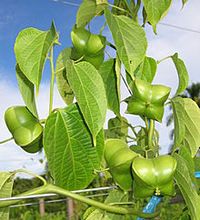
In a farmer's garden deep in the Peruvian Amazon, two researchers saw a plant they did not recognize. Its plump, green seed pods resembled those of a family of plants known in Peru as sacha inchi, which produce oil rich in omega-3 fatty acids. But the pods of the new plant, later dubbed Plukenetia carolis-vegae, were bigger than those sprouted by the known sacha inchi species Plukenetia volubilis (picture right) and Plukenetia huayllabambana.
They had stumbled on a species unknown to science and hope to transform it into a 'conservation crop' that can be raised commercially in the shade beneath the Amazon's forest canopy, without cutting down any trees. More
Underground communication
Plants can communicate the onset of an attack from aphids by making use of an underground network of fungi, researchers have found. Instances of plant communication through the air have been documented. But below ground, most land plants are connected by fungal mycorrhizae and a new study demonstrates that these fungi also aid in communication.
The team grew sets of five broad bean plants, allowing three in each group to develop mycorrhizal networks, and preventing the networks' growth in the other two. To prevent any through-the-air chemical communication, the plants were covered with bags. Single plants in the sets were infested with aphids and, if the infested plant was connected to another by the mycorrhizae, the un-infested plant began to mount its chemical defence. Those unconnected by the networks appeared not to receive the signal of attack, and showed no chemical response. More
Events Calendar
In Vitro Culture and Horticultural Breeding
2 - 7 Jun, International Society for Horticultural Science
Coimbra, Portugal
International Mango Symposium
2 - 7 Jun, International Society for Horticultural Science
Punta Cana, Dominican Republic
Plant Photobiology
3 - 6 Jun, University of Edinburgh
Edinburgh, UK
European Biomass Conference
3 - 7 Jun, European Commission
Copenhagen, Denmark
Controlled and Modified Atmosphere Research
3 - 7 Jun, International Society for Horticultural Science
Trani, Italy
Workshop on Sap Flow
3 - 7 Jun, International Society for Horticultural Science
Ghent, Belgium
Symposium on Elderberry (Sambucus)
9 - 14 Jun, International Society for Horticultural Science
Columbia, USA
Induced resistance in plants against insects and diseases
10 - 13 Jun, INRA
Avignon, France
Medicinal Plants and Natural Products
17 - 19 Jun, International Society for Horticultural Science
Montreal, Canada
Peach Symposium
17 - 20 Jun, International Society for Horticultural Science
Matera, Italy
Growing Media and Soil-less Cultivation
17 - 21 Jun, International Society for Horticultural Science
Leiden, The Netherlands
Food Waste Along the Supply Chain
20 - 21 Jun, OECD
Paris, France
Cherry Symposium
23 - 27 Jun, International Society for Horticultural Science
Plasencia, Spain
Oxidative stress and cell death in plants
26 - 28 Jun, Society of Experimental Biology
Florence, Italy
European Association for Potato Research and Eucarpia Potato Congress
30 Jun - 4 July, James Hutton Institute
Hévíz, Hungary
Tomato Diseases: Economically, Environmentally, and Socially Sustainable Tomato Disease Management
24 Jun - 27 Jun, International Society for Horticultural Science
Orlando, USA
Global Vegetable Congress
27 Jun - 28 Jun, Eurofruit and Fresh Produce Journal
Almeria, Spain
Postharvest and Quality Management of Horticultural Products of Interest for Tropical Regions
1 - 5 Jul, International Society for Horticultural Science
Port of Spain, Trinidad
Fireblight
2 - 5 Jul, International Society for Horticultural Science
Zurich, Switzerland
Taxonomy of Cultivated Plants
15 - 19 Jul, International Society for Horticultural Science
Beijing, China
Pecans and Other Carya in Indigenous and Managed Systems
17 - 20 Jul, International Society for Horticultural Science
College Station, USA
Fruit for the Future
18 Jul, James Hutton Institute
Dundee, UK
Walnut Symposium
20 - 23 Jul, International Society for Horticultural Science
Taiyuan, China
Plant Bioregulators in Fruit Production
28 - 31 Jul, International Society for Horticultural Science
Orlando, USA
Jojoba world
30 - 31 July, Centre for Jatropha Promotion & Biodiesel
Jaipur, India
C4 and CAM Plant Biology
6 - 9 Aug, University of Illinois
Champaign, USA
Potatoes in Practice
8 Aug, James Hutton Institute
Dundee, UK
Photosynthesis: Opportunities and Challenges of the 21st Century
11 Aug, University of Illinois
St Louis, USA
Plant Cryopreservation
11 - 14 Aug, International Society for Horticultural Science
Fort Collins, USA
Horticulture Economics, Marketing and Consumer Research
19 - 21 Aug, International Society for Horticultural Science
Portland, USA
Plantarium
21 - 24 Aug, Plantarium
Boskoop, The Netherlands
Rose Research and Cultivation
25 - 30 Aug, International Society for Horticultural Science
Hanover, Germany
Phylloxera
28 - 30 Aug, International Society for Horticultural Science
Bordeaux, France
If you would like to advertise a forthcoming event please contact. karen.hobbs@soci.org
Horticulture Group Contact Details
For submitting ideas or to volunteer to be part of a committee or a group, please contact:
Chairman - Peter Grimbly
Meetings Secretary - Alison Foster
Minutes Secretary - Margaret Waddy
Newsletter co-ordinator - Sue Grimbly scihortigroup@btinternet.com
Group Contact - Karen Hobbs, E: karen.hobbs@soci.org T: +44(0)20 7598 1586

